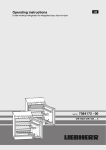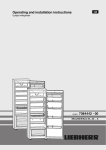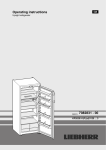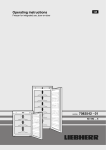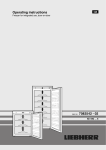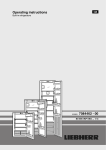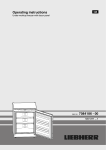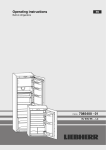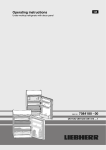Download Liebherr IKP 2060 Premium
Transcript
Operating instructions Built-in refrigerators 300709 7084194 - 00 IKP/ SIKP ... 6 Appliance at a glance Contents 1 1.1 1.2 1.3 1.4 Appliance at a glance............................................ Range of appliance use............................................ Conformity................................................................ Description of appliance and equipment.................. Saving energy.......................................................... 2 2 2 2 2 2 General safety information................................... 3 3 3.1 3.2 Controls and displays........................................... Operating and control elements............................... Temperature display................................................. 3 3 3 4 4.1 4.2 4.3 4.4 4.5 Putting into operation............................................ Transporting the appliance....................................... Installing the appliance............................................. Disposing of packaging............................................ Connecting the appliance......................................... Switching on the appliance....................................... 3 3 3 4 4 4 5 5.1 5.2 5.3 5.4 Control.................................................................... Brightness of the temperature display...................... Child proofing........................................................... Refrigerator compartment........................................ Freezer compartment............................................... 4 4 5 5 6 6 6.1 6.2 6.3 Maintenance........................................................... Manual defrosting..................................................... Cleaning the appliance............................................. Customer service..................................................... 6 6 7 7 7 Malfunction............................................................. 7 8 8.1 8.2 Decommissioning.................................................. Switching off the appliance....................................... Taking the appliance out of service.......................... 8 8 8 9 Disposing of the appliance................................... 8 Climate rating for ambient temperatures of SN 10 °C to 32 °C N 16 °C to 32 °C ST 16 °C to 38 °C T 16 °C to 43 °C 1.2 Conformity The refrigerant circuit has been tested for leaks. When installed, this appliance complies with the relevant safety provisions and EC directives 2006/95/EC and 2004/108/EC. 1.3 Description of appliance and equipment The manufacturer works constantly on the further development of all the types and models. Therefore please understand that we have to reserve the right to make design, equipment and technical modifications. To get to know all the benefits of your new appliance, please read the information contained in these instructions carefully. The instructions apply to several models. Differences may occur. Text relating only to specific appliances is marked with an asterisk (*). Instructions for action are marked with a , the results of action are marked with a . 1 Appliance at a glance 1.1 Range of appliance use The appliance is suited only for cooling food. In the case of commercial food cooling, the pertinent statutory regulations have to be observed. The appliance is not suited for storing and cooling pharmaceuticals, blood plasma, laboratory preparations or similar substances and products subject to the Medical Devices Directive 2007/47/EC. Any misuse of the appliance may result in damage to or spoilage of the stored goods. Furthermore, the appliance is unsuited for use in areas exposed to an explosion hazard. The appliance is set to operate within specific ambient temperature limits according to its climate rating. The correct climate rating for your appliance is indicated on the type plate. Note u Compliance with the ambient temperatures indicated is required, otherwise the cooling performance is reduced. Fig. 1 (1) Operating and control elements (2) Butter and cheese compartment (3) Fan* (4) Shelf, sectioned (5) Holder for bottles and tinned food, relocatable (6) Rack for tinned food, relocatable (7) Shelf, relocatable (8) Interior light (9) Rack for tall bottles (10) Freezer compartment* (11) Bottle shelf (12) Coldest zone (13) Drain hole (14) Type plate (15) Vegetable bins* (16) Vegetable bins on roller plates* (17) Adjustable-height feet at the front 1.4 Saving energy - Always pay attention to good ventilation. 2 General safety information - Keep the time the appliance is open to a minimum. Store food logically. First cool warm food to room temperature before storing it . Defrost frozen food in the refrigerator.* If there is a thick layer of frost in the appliance: defrost the appliance.* 2 General safety information Danger for the user: - This appliance is not designed for persons (including children) with physical, sensory or mental impairment or persons not having sufficient experience and knowledge, unless they are instructed in the use of the appliance and are initially supervised by a person responsible for their safety. Keep children under supervision to ensure they do not play with the appliance. - In case of a fault, pull out the mains plug (not by pulling the connecting cable) or switch off the fuse. - Have any repairs to or intervention in the appliance, and any change of the mains power cable, carried out by the customer service only or by other specialised personnel trained for the purpose. - When disconnecting the appliance from the supply, always take hold of the plug. Do not pull the cable. - Install and connect the appliance only as instructed. - Please keep these instructions in a safe place and pass them on to any subsequent owners. Fire hazard: - The refrigerant R 600a is environmentally friendly but flammable. Escaping refrigerant may ignite. • Do not damage the refrigerant circuit pipes. • Do not allow naked flames or ignition sources to enter the appliance. • Do not use any electrical appliances in the interior (e.g. steam cleaners, heaters, ice cream maker etc.). • If refrigerant escapes: eliminate naked flames or sources of ignition from the vicinity. Pull out the power plug. Ventilate the area well. Notify customer service. - Do not store explosives or sprays using combustible propellants such as butane, propane, pentane, etc. in the appliance. Respective spray cans can be identified by reference to the contents printed on the can or by a flame symbol. Gases possibly escaping may ignite due to electrical components. - Only store high-percentage alcohol in tightly sealed, upright containers. Alcohol possibly escaping may ignite due to electrical components. Danger of tipping and falling: - Do not misuse the plinth, drawers, doors etc. as a step or for support. This applies particularly to children. Danger of food poisoning: - Do not consume food which has been stored too long. Danger of frostbite, numbness and pain: - Avoid lasting skin contact with cold surfaces or refrigerated/ frozen food or take protective steps, e.g. wear gloves. Do not consume ice cream, water ice or ice cubes immediately and do not consume them too cold. Risk of crushing* Please observe the specific information in the other sections: DANGER identifies a situation involving direct danger which, if not obviated, may result in death or severe bodily injury. WARNING identifies a dangerous situation which, if not obviated, may result in death or severe bodily injury. CAUTION identifies a dangerous situation which, if not obviated, may result in minor or medium bodily injury. NOTICE identifies a dangerous situation which, if not obviated, may result in damage to property. Note identifies useful information and tips. 3 Controls and displays 3.1 Operating and control elements Fig. 2 (1) Temperature display (2) Up setting button (3) Down setting button (4) Child lock symbol (5) On/Off button (6) SuperCool button (7) Fan button 3.2 Temperature display The following are displayed in normal operation: - the average cooling temperature The following displays indicate malfunction. Possible causes and corrective action (see Malfunction). - F0 to F5 4 Putting into operation 4.1 Transporting the appliance CAUTION Risk of injury and danger of damage as a result of incorrect transport! u Transport the appliance in a packed condition. u Transport the appliance upright. u Do not transport the appliance without assistance. 4.2 Installing the appliance In the event that the appliance is damaged, contact the supplier immediately before connecting to the mains. The floor at the site must be flat and level. Do not install the appliance in a location where it is exposed to direct radiation of the sun, next to a cooker, heater and similar. Do not install the appliance without assistance. 3 Control Standard EN 378 specifies that the room in which you install your appliance must have a volume of 1 m 2 per 8 g of R 600a refrigerant used in the appliance. If the room in which the appliance is installed is too small, a flammable gas-air mixture may form in the event of a leakage in the refrigeration circuit. The quantity of refrigerant used in your appliance is indicated on the type plate on the inside of the appliance. Fit the appliance in stable kitchen units only. The following ventilation gaps must be observed: q The depth of the ventilation channel at the rear of the unit must be at least 38 mm. q There must be a ventilation space of at least 200 cm2 in the plinth and at the top of the unit. q Basically the principle applies: the larger the ventilation space, the more energy-saving the appliance is in operation. WARNING Fire hazard due to dampness! If live parts or the mains lead become damp this may cause short circuits. u The appliance is designed for use in enclosed areas. Do not operate the appliance outdoors or in areas where it is exposed to splash water or damp conditions. WARNING Fire hazard due to refrigerant! The refrigerant R 600a is environmentally friendly but flammable. Escaping refrigerant may ignite. u Do not damage the piping of the refrigeration circuit. WARNING Fire hazard and danger of damage! u Do not place appliances emitting heat e.g. microwaves, toasters etc. on the appliance! Note* The aluminium-coloured bags at the back of the appliance are important for the functional efficiency. Their contents are nontoxic and nonhazardous. u Do not remove the aluminium-coloured bags! u Detach the connecting cable from the rear of the appliance, removing the cable holder at the same time because otherwise there will be vibratory noise! After installation: u Remove the protective film from the decorative trims. u Remove the protective film from the decorative trims and drawer fronts.* u Remove all transit supports. u Dispose of packaging material (see 4.3) . NOTICE Risk of damage due to condensate! If your appliance is not a Side-by-Side (SBS) appliance: u do not install the appliance directly alongside a further refrigerator/freezer. If the appliance is installed in a very damp environment, condensate may form on the outside of the appliance. u Always see to good ventilation at the installation site. 4.3 Disposing of packaging WARNING Danger of suffocation due to packing material and plastic film! u Do not allow children to play with packing material. 4 The packaging is made of recyclable materials: - corrugated board/cardboard - EPS moulded parts - polythene bags and sheets - polypropylene straps u Take the packaging material to an official collecting point. 4.4 Connecting the appliance NOTICE Risk of damage to the electronic control system! u Do not use stand-alone inverters (conversion of d.c. to a.c./ three-phase) or energy saving plugs. WARNING Fire and overheating hazard! u Do not use extension cables or multiple socket outlets. The type of current (alternating current) and voltage at the installation site have to conform with the data on the type plate (see Appliance at a glance). Connect the appliance only with a properly installed socket outlet with earthing contact. The socket outlet must be fused with 10 A or higher. u Check the electrical connection. u Clean the appliance . u Plug in the power plug. 4.5 Switching on the appliance Put the appliance into operation about 2 hours before first loading food to be frozen.* u Press On/Off button Fig. 2 (5). w The temperature display indicates the current temperature. w The interior light is on when the door is open. 5 Control 5.1 Brightness of the temperature display You can adjust the brightness of the temperature display to the light conditions of the room in which the appliance is installed. 5.1.1 Adjusting the brightness The brightness is adjustable between h1 (minimum luminosity) and h5 (maximum luminosity). u To activate the setting mode: press SuperCool button Fig. 2 (6) for about 5s. w The display indicates c. w The SuperCool button flashes. u Using the Up setting button Fig. 2 (2) and Down setting button Fig. 2 (3), select h. u To confirm: briefly press the SuperCool button Fig. 2 (6). u To set the display brighter: press the Up setting button Fig. 2 (2). u To set the display darker: press the Down setting button Fig. 2 (3). u To confirm: briefly press the SuperCool button Fig. 2 (6). w The brightness is adjusted to the new value. u To deactivate the setting mode: press the On/Off button Fig. 2 (5). -or- Control u Wait for 5 minutes. 5.3.3 SuperCool w The temperature is indicated again in the temperature display. With SuperCool you switch to the highest cooling performance to reach lower cooling temperatures. Use SuperCool, to rapidly cool large amounts of food. When SuperCool is activated, the fan runs. The appliance operates with maximum refrigeration. The noise of the refrigeration unit may be temporarily louder as a result. The SuperCool function uses slightly more energy. 5.2 Child proofing The child-proofing function enables you to make sure that the appliance is not inadvertently switched off by playing children. 5.2.1 Setting the child lock u To activate the setting mode: Press the SuperCool button Fig. 2 (6) for approx. 5 seconds. w The SuperCool button flashes. The display indicates c. u Briefly press the SuperCool button Fig. 2 (6) to confirm. u To switch on: Using the Up setting button Fig. 2 (2) or Down setting button Fig. 2 (3) , select c 1. u To switch off: Using the Up setting button Fig. 2 (2) or Down setting button Fig. 2 (3) , select c 0 wählen. u To confirm: Press the SuperCool button Fig. 2 (6). w When the child lock symbol Fig. 2 (4) shines, the child lock is activated. u To deactivate the setting mode: Press the On/Off button Fig. 2 (5). -oru Wait for 5 minutes. w The temperature is indicated again in the temperature display. 5.3 Refrigerator compartment The natural circulation of air in the refrigerator compartment results in zones differing in temperature. It is coldest directly above the vegetable drawers and at the rear wall. It is warmest at the top front of the compartment and in the door. 5.3.1 Food refrigeration u Store perishable food such as ready-to-serve dishes, meat products and sausages in the coldest zone. Place butter, eggs and preserves in the upper area and in the door (see Appliance at a glance). u Use recyclable plastic, metal, aluminium and glass containers and cling film for wrapping. For appliances from 1216 mm high: u Use the front area of the refrigerator compartment floor only for briefly putting down cooled products, e.g. when rearranging and sorting. However do not leave cooled products there otherwise they may be pushed back or tipped over when the door is closed. u Do not store food too close together to enable good air circulation. u To safeguard bottles from tipping over: move the bottle holder. Cooling with SuperCool u Briefly press SuperCool button Fig. 2 (6). w The SuperCool button Fig. 2 (6) lights up. w The cooling temperature drops to the coldest value. SuperCool is activated. w SuperCool is automatically deactivated after 6 to12 hours The appliance continues to operate in the energy-saving, normal mode. To prematurely deactivate SuperCool u Briefly press SuperCool button Fig. 2 (6). w The SuperCool button Fig. 2 (6) goes out. w SuperCool is deactivated. 5.3.4 Fan* With the fan you can rapidly cool large quantities of fresh food or achieve a relatively even distribution of temperature across all the storage levels. The forced-air cooling is to be recommended: - at high room temperature (from approx. 30 °C ) - at high humidity The forced-air cooling uses slightly more energy. To save energy, the fan switches off automatically when the door is open. Switching on the fan* u Briefly press the fan button Fig. 2 (7). w The fan button shines. w The fan is active. It switches on automatically when the compressor runs. To switch off the fan* u Briefly press the fan button Fig. 2 (7). w The fan button goes out. w The fan is switched off. 5.3.5 Relocating the shelves The shelves have stops preventing them from being unintentionally pulled out. u Lift the shelf and draw it out forwards. 5.3.2 Setting the temperature The temperature can be set from 9 °C to 2 °C, the recommended temperature is 5 °C. An average temperature of about –18 °C is reached in the freezer compartment.* u For a higher temperature setting: press Up button Fig. 2 (2). u For a lower temperature setting: press Down button Fig. 2 (3). w The first time the button is pressed, the value set so far is indicated in the temperature display. u To change the temperature in 1 °C steps: briefly press the button. u To change the temperature continuously: hold down the button. w The value is displayed flashing during the setting operation. w The actual temperature is displayed about 5 s after the last press of a button. The temperature slowly adjusts to the new value. u Insert shelf with the raised edge pointing upwards at the back. w The food does not freeze onto the rear wall. 5.3.6 Using the sectioned shelf Fig. 3 5 Maintenance u The glass shelf with stop face (2) has to be at the back. 5.3.7 Moving the storage rack u Remove storage rack according to illustration. Always remove the butter and cheese compartment together with the lid. u To remove lid: Press one side part of the butter and cheese compartment outwards until the lid pin is clear and then remove the lid sideways. 5.3.8 Removing the bottle holder u Always take hold of the bottle holder on the plastic part. Guide times for storing various types of food in the freezer compartment: Fish, fatty 2 to 6 months Fish, lean 6 to 12 months Cheese 2 to 6 months Poultry, beef 6 to 12 months Vegetables, fruit 6 to 12 months Storage times given are guide times. 5.4.3 Thawing food u in the refrigerator compartment at room temperature in a microwave oven in a conventional or fan oven Food once thawed should be re-frozen only in exceptional cases. 6 Maintenance 6.1 Manual defrosting 6.1.1 Defrosting refrigerator compartment 5.4 Freezer compartment* You can store frozen food for several months, make ice cubes and freeze fresh food in the freezer compartment at a temperature of -18 °C and lower. The air temperature in the compartment, measured by thermometer or other instruments, may fluctuate. 5.4.1 Freezing food* 2 kg fresh food/24 h is the maximum weight which can be frozen. CAUTION Risk of injury due to broken glass! Bottles and cans containing drinks may burst when being frozen. This applies particularly to sparkling drinks. u Do not freeze bottles and cans containing drinks! u 4 h before freezing food, set the temperature to 5 °C or colder. In order that the food is rapidly frozen through to the core, do not exceed the following quantities per pack: - Fruit, vegetables up to 1 kg - Meat up to 2.5 kg u Pack the food in portions in freezer bags, reusable plastic, metal or aluminium containers. u Spread the food over the shelf. Do not allow it to contact and thaw items that are already frozen. u Set the temperature back again 24 h after placing the food inside. 5.4.2 Storage times* Guide times for storing various types of food in the freezer compartment: Ice cream 2 to 6 months Sausage, ham 2 to 6 months Bread, bakery products 2 to 6 months Game, pork 6 to 10 months 6 The refrigerator compartment is defrosted automatically. The defrost water evaporates as a result of the heat of the compressor. Drops of water on the rear wall are perfectly normal. u Clean the drain hole at regular intervals to allow the defrost water to drain (see 6.2) . 6.1.2 Defrosting freezer compartment* A layer of frost and ice forms in the freezer compartment after the appliance has been in use for a lengthy period of time. This is quite normal. The layer of frost and ice forms more quickly if the door is opened frequently or if the food is warm when placed inside. However, a thick layer of ice will increase the appliance‘s energy consumption. You should therefore defrost the appliance regularly. CAUTION Risk of injury and damage as a result of hot steam! u Do not use electric heaters or steam cleaners, naked flames or defrosting sprays for defrosting. u Do not remove ice using sharp instruments. u Switch off the appliance. w The temperature display goes out. w If the temperature display does not go out, the child-proofing function (see 5.2) is active. u Pull out the plug. u Wrap the frozen food in newspaper or blankets and store in a cool place. u Place a pan with hot, not boiling water on the floor of the compartment. w Defrosting is speeded up. u Leave the compartment and appliance door open during defrosting. u Remove detached pieces of ice. u Pay attention that the defrost water does not run into the kitchen unit. u If necessary, pick up defrost water several times, using a sponge or cloth. u Clean the compartment (see 6.2) . Malfunction 6.2 Cleaning the appliance. Before cleaning: CAUTION Risk of injury and damage as a result of hot steam! Hot steam may damage the surfaces and cause burns. u Do not use any steam cleaners! NOTICE Incorrect cleaning damages the appliance! u Do not use cleaning agents in concentrated form. u Do not use any scouring or abrasive sponges or steel wool. u Do not use any cleaning agents containing sand, chloride, chemicals or acid. u Do not use chemical solvents. u Do not damage or remove the type plate on the inside of the appliance. It is important for the customer service. u Do not pull off, bend or damage cables or other components. u Do not allow any cleaning water to enter the drain channel, ventilation grille or electrical parts. u Empty the appliance. u Pull out the plug. - Use soft cleaning cloths and a multi-purpose cleaning agent with neutral pH value. - Only use food compatible cleaning and care agents on the inside of the appliance. u Clean the plastic surfaces, outside and inside, by hand using lukewarm water and a little washing-up liquid. u To clean the drain opening: remove any deposits with a fine instrument, e.g. a cotton bud. Items of equipment: u Clean roller plates in the dishwasher.* u Clean other items of equipment by hand with lukewarm water and a little washing-up liquid. u For cleaning, remove the support rails for the half-sized glass shelves. u To dismantle the shelves: remove the trims and side parts. u To dismantle the storage rack: remove the protective film from the decorative trims. After cleaning: u Wipe dry the appliance and items of equipment. u Connect the appliance and switch it on again. u Put the food back inside. 6.3 Customer service First check whether you can correct the fault yourself by reference to the list (see Malfunction). If this is not the case, please contact the customer service whose address is given in the enclosed customer service list. WARNING Risk of injury if repair work is not carried out professionally! u Have any repairs to and intervention in the appliance and mains power cable, which are not expressly mentioned in the (see Maintenance) carried out by the customer service only. u Read the appliance designation Fig. 4 (1), service No. Fig. 4 (2) and serial No. Fig. 4 (3) off the type plate located inside the appliance on the lefthand side. Fig. 4 u Notify the customer service, specifying the fault, appliance designation Fig. 4 (1), service No. Fig. 4 (2) and serial No. Fig. 4 (3). w This will help us to provide you with a faster and more accurate service. u Keep the appliance closed until the customer service arrives. w The food will stay cool longer. u Pull out the mains plug (not by pulling the connecting cable) or switch off the fuse. 7 Malfunction Your appliance is designed and manufactured for a long life span and reliable operation. If a malfunction nonetheless occurs during operation, check whether it is due to a handling error. In this case you will have to be charged for the costs incurred, even during the warranty period. You may be able to rectify the following faults yourself: Appliance does not work. → The appliance is not switched on. u Switch on the appliance. → The power plug is not properly inserted in the wall socket. u Check power plug. → The fuse of the wall socket is not in order. u Check fuse. The compressor runs for a long time. → The compressor switches to a low speed when little cold is needed. Although the running time is increased as a result, energy is saved. u This is normal in energy-saving models. → SuperCool is activated. u The compressor runs for longer in order to rapidly cool the food. This is normal. Excessive noise. → Speed-controlled* compressors may produce varying running noise due to different speed steps. u The sound is normal. A bubbling and gurgling noise. → This noise comes from the refrigerant flowing in the refrigeration circuit. u The sound is normal. A quiet clicking noise. → The noise is produced whenever the refrigeration unit (motor) automatically switches on or off. u The sound is normal. A hum. It is briefly a little louder when the refrigeration unit (the motor) switches on. → The refrigeration increases automatically when the SuperCool function is activated, fresh food has just been placed in the appliance or the door has been left open for a while. u The sound is normal. → The ambient temperature is too high. u Solution: (see 1.1) A low hum.* → The sound is produced by air flow noise of the fan. u The sound is normal. 7 Decommissioning Vibratory noise. → The appliance is not standing firmly on the floor. As a result, adjoining units or objects are set into vibration by the running refrigeration unit. u Move bottles and containers apart. Flow sound at the soft stop mechanism.* → The noise is produced when the door is opened and closed. u The sound is normal. 9 Disposing of the appliance The temperature display indicates: F0 to F5. When disposing of the appliance, ensure that the refrigeration circuit is not damaged to prevent uncontrolled escape of the refrigerant it contains (data on type plate) and oil. u Disable the appliance. u Pull out the plug. u Cut through the connecting cable. → There is a fault. u Contact the customer service (see Maintenance). The temperature is not cold enough. → The door of the appliance is not properly closed. u Close the door of the appliance. → Insufficient ventilation. u Clear ventilation grilles. → The ambient temperature is too high. u Solution: (see 1.1) . → The appliance was opened too frequently or for too long. u Wait until the appliance reaches the required temperature itself. If not, contact the customer service. (see Maintenance). → The temperature is incorrectly set. u Set to a colder temperature and check after 24 h. → The appliance is too close to a heat source. u Solution: (see Putting into operation). → The appliance was not inserted properly into the recess. u Check whether the appliance was inserted correctly and the door closes properly. The interior light is not on. → The appliance is not switched on. u Switch on the appliance. → If the interior light is not on but the temperature display is lit, the bulb is faulty. u Change the bulb: (see Maintenance) → The LED lighting is defective or the cover is damaged: WARNING Risk of injury due to electric shock! Live parts are located under the cover. u Have the LED interior light changed or repaired only by the customer service or by specialized personnel trained for the purpose. WARNING Danger of injury due to laser radiation, class 1M. u Do not look inside when the cover is open. 8 Decommissioning 8.1 Switching off the appliance u Press On/Off button Fig. 2 (5) for about 2 s. w The temperature display is dark. 8.2 Taking the appliance out of service u Empty the appliance. u Pull out the power plug. u Clean the appliance . u Leave the door open to prevent odour. 8 The appliance contains some reusable materials and should be disposed of properly - not simply with unsorted household refuse. Appliances which are no longer needed must be disposed of in a professional and appropriate way, in accordance with the current local regulations and laws.








